Canning jars are a favorite plastic-free method of food storage for a lot of people, but what about freezing mason jars? Can you freeze in mason jars? Yes, you can, but there are some guidelines for safety that you should follow.
Mason jars are the go-to for home canning recipes, but they can also be used to freeze food. Surprisingly, this is a bit of a contentious subject. Some people won’t even consider the idea of freezing mason jars. They’re just too worried about breakage.
Does glass break in the freezer?
Not automatically. Glass jars won’t just spontaneously burst in the freezer. What causes glass to break in the freezer is the expansion of the food stored in glass as it freezes. If there’s not enough space to allow for that expansion, the food will push against the glass, causing breakage.
I’ve been freezing food in glass jars for years upon years and in all that time I think I’ve had three break. Each time? It was my fault for not following safe practices.
What happens when a jar breaks?
5 Easy Steps to Transform Your Pantry!
Ready to switch from store bought to homemade? Let me help you make some changes! Grab my FREE five-part guide to getting started.
In my experience, a jar that does break in the freezer will simply crack in several places, but retain its shape. If you find a broken glass in the freezer, remove the jar carefully and transfer it to a bucket or bowl and allow the contents to thaw. Once thawed, you can safely dispose of the pieces of glass that remain and trash the rest. I’d avoid composting it, just in case any fragments of glass remain.
What can you freeze in mason jars?
As long as you follow the guidelines laid out below, you can freeze most things in glass jars. Freeze smoothies so they’re ready to grab and go for lunch. Freeze bone broth, homemade soup, chili, or fruit juice. You can freeze cooked beans to have them ready for adding to meals or making hummus. You can freeze fresh berries or pesto. And you can even freeze homemade jams and jellies.
The Handcrafted Pantry

Ready to DIY your pantry with more wholesome ingredients? Check out my ebook, The Handcrafted Pantry! Filled with delicious recipes for some of your favorite condiments, snacks, and toppings, it’s the guide you need to start skipping packaged products and embrace homemade.
Freezing mason jars safely
Mason jars are an environmentally sound option for food storage and are perfectly suitable for freezing food. You just need to follow some simple safety guidelines.
1. Choose freezer safe jars
While you can freeze glass, opt for mason jars out of an abundance of caution. Reuse glass jars from the supermarket for storing bulk dry food, not freezing. Mason jars have thicker glass and are sturdier than recycled jars.
To prevent breakage, your best bet for freezing jars is to use straight-sided mason jars. This allows the food inside to shift upwards as it freezes. Jars with “shoulders” impede that movement and are more likely to break when frozen. These straight-sided jars are available in 4 ounce, half-pint, pint and 24 ounce sizes.
2. Leave enough head space
This is key! If you fill the jar all they way to the top, put a lid on it, and pop it in the freezer, that expanding food has nowhere to go. That’s how breakage happens. The trapped food expands and pushed against the glass until it breaks. The National Center for Home Canning suggests 1/2″ head space for pint sized jars no matter what you’re freezing. For quarts, they suggest a 1″ head space for liquids and 1/2″ for “dry pack” items like fruit without liquids or nuts.
I tend to be even more conservative when I’m freezing food in glass, and rarely use less than an inch of head space, and more like an inch and a half (or two!) when freezing liquid in quart jars.
If you’re freezing in mason jars with shoulders because that’s all you have available, measure the head space from the shoulder, not the rim of the jar.
3. Cool before freezing mason jars
You’ll want to avoid temperature fluctuations when freezing food in glass. Don’t put warm jars directly into the freezer. Instead, put jars of broth or soup in the refrigerator overnight, then transfer to the freezer.
4. Opt for plastic lids
I know, we’re trying to use less plastic when freezing our food. And this is not a safety issue as much as it is a cautionary tale. Metal lids and rings will work fine for sealing the jars, but they do tend to rust when used as freezer storage, eventually becoming unusable. Plastic lids have no such problem and they can be reused over and over again. In the end, I feel like this is the better use of resources.
5. Thaw frozen jars safely
In other words, plan ahead. The one drawback to freezing in glass is that the food inside is not readily available. If you need a jar of broth for a recipe, you’ll need to thaw it out ahead of time. You may be tempted to run the frozen jar under a stream of warm water to hurry up the process, but restrain yourself. Exposing mason jars to temperature fluctuations when they come out of the freezer can cause breakage.
To safely thaw frozen jars, set them on a towel at room temperature. The towel will absorb the liquid that condenses on the outside of the jar as it thaws, saving you a mess.
Once the contents are mostly thawed, transfer to the refrigerator or add to your recipe.
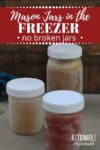
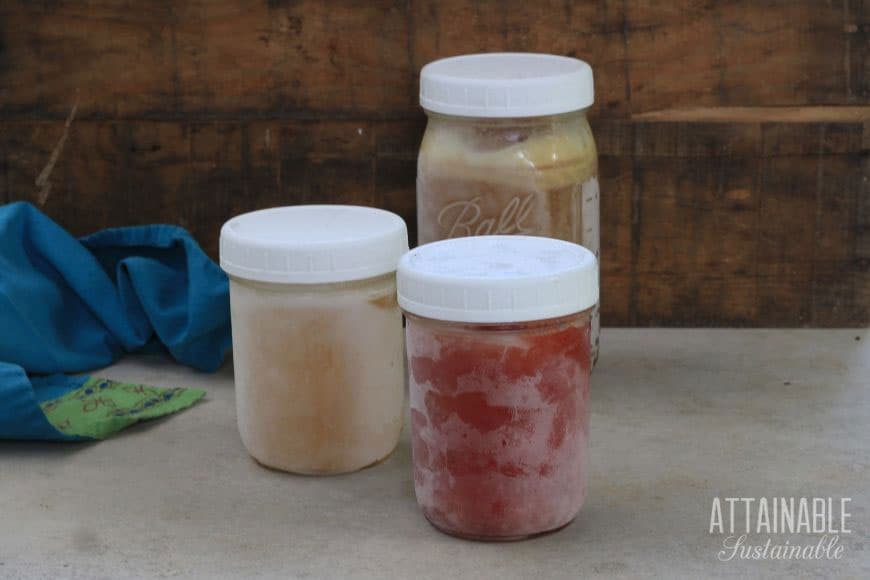
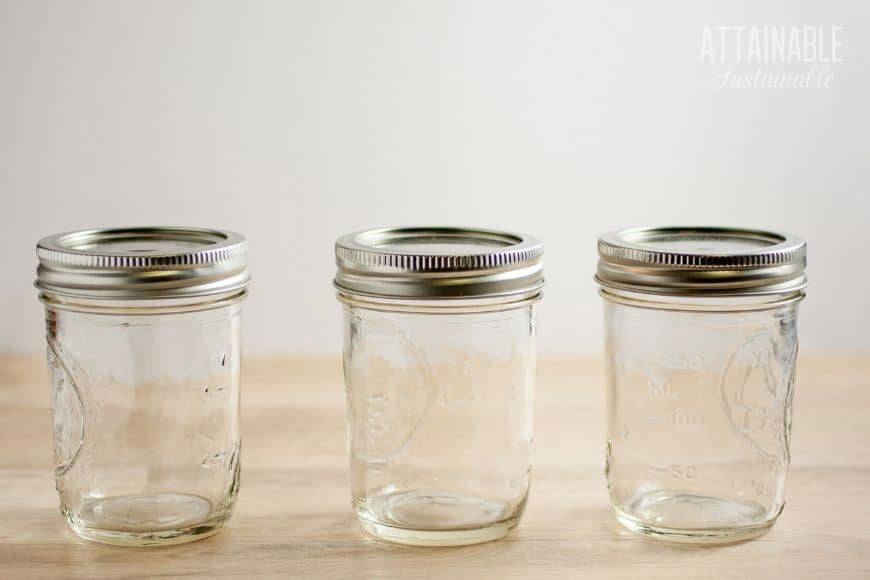
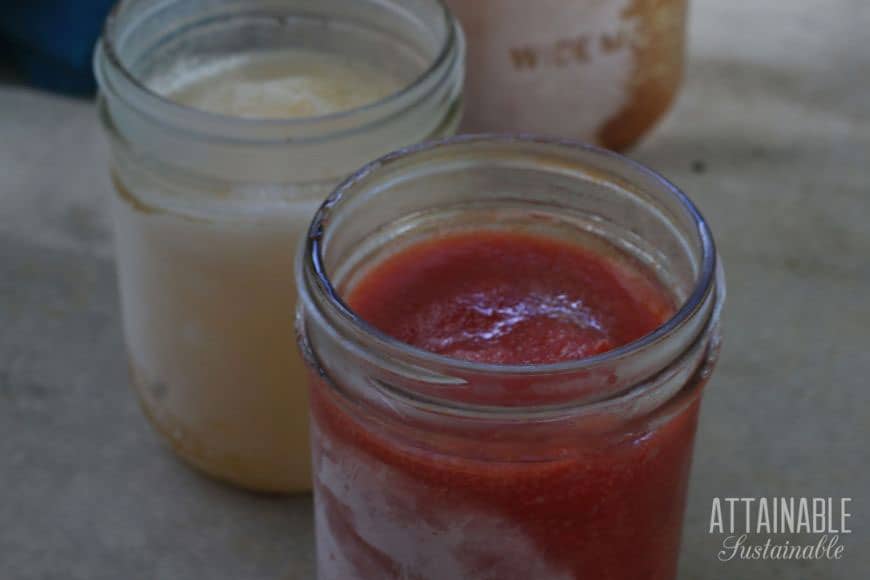
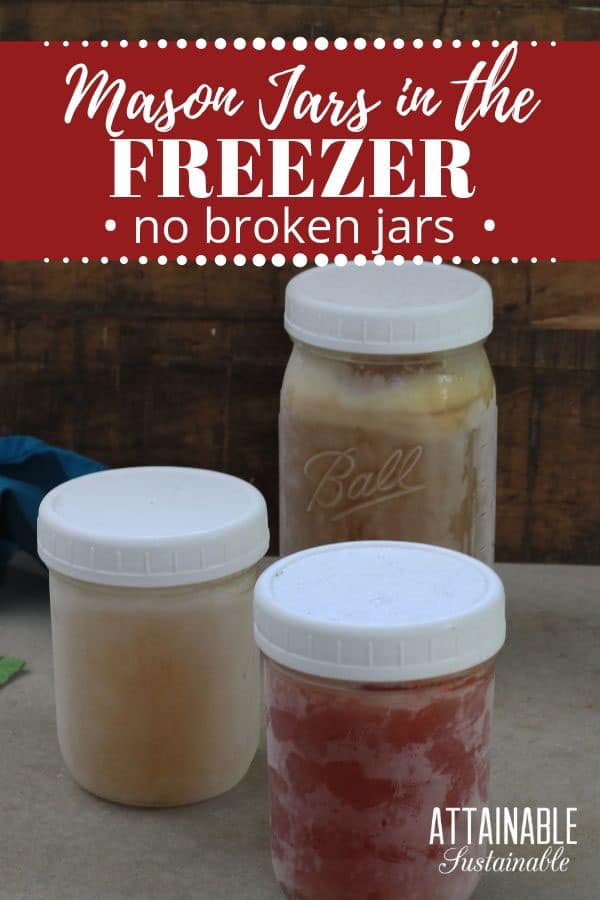





To avoid the problem of using jars with shoulders, I have successfully laid them on their sides to freeze, thereby allowing ample room for expansion.
It’s good to know that works!
When I tried using ball jars for freezing stock, I left plenty of headspace and they were fine… until I needed to shift things around in my tiny freezer. Two glass jars clunked together and both cracked! Any good way to prevent this?
Bummer! Other than what’s mentioned in this post, I’d suggest storing them with other items in between. Good luck!
I use my old (clean) soxes. Cut off the foot, and slip it over the jar to use as padding.
How and what do you suggest for freezing fresh fruits and veggies from the garden
Inexpensively!!!
Tis that time of the year,,!!
There are tons of options for preserving your harvest besides freezing. I recommend checking out canning and fermenting, I have many recipes on my site you might like!
Remember that as liquid freezes, it pushes out the air as it expands. One trick I’ve used successfully it to place a metal lid on the jar before screwing on the plastic lid. Then you have no leakage, and the metal lid does not rust.
I’ve had a couple Ball jars break just with water in them and no lid, its weird, I’ll be trying some straight sided ones in the future and as far as I can tell the Ball plastic lids are at least airtight on their own jars.
I love using glass over plastic and won’t go back, but god damn is it ever annoying sometimes
Thanks for the comment about plastic lids, I wasn’t aware that they made them. I remember my Mom using the metal two piece lids for Mason jars.
I am going to be putting home made lemon liqueur in the freezer so it shouldn’t freeze but I will follow your rules regardless.
(60 proof so maybe 30% alcohol, that should make an effective anti-freeze!)
Maybe reduce the head space a bit, though… 😉
Just a note about the plastic lids: they are NOT airtight! If you don’t believe me, just put some water in a jar, put a plastic lid on and shake: it will leak. I keep forgetting this, and when I go to shake something I have thawed out that is liquid, it always leaks on me, and actually, quite a bit! SO frustrating. My guess is that they won’t keep foods as long due to air getting inside and we all know that air ruins frozen foods. Just something to keep in mind.
Just a quick update. I heard that Ball (?) just came out with airtight plastic lids. Please check Mary’s Nest on YouTube, or Ball’s website.
Yes and they are MUCH better for storing dry goods long term!